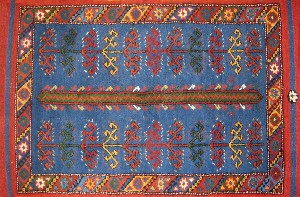Honoring and reviving traditional dyeing skills:
A Journey in Guatemala
by Judith Musick
When I was a child, I always picked the most vibrantly colored crayons for the pictures I drew. Carrying this fondness forward to adulthood, I chose a bright palette to accent my clothes, and house, and garden: turquoise or red beads against a black sweater; yellow, violet or orange flowers against the greens of my garden, and floors adorned with Moroccan rugs in vivid hues. Once, during a long, housebound snowy winter with my small children, I painted the front hall closet a truly dreadful royal blue. As a knitter and tapestry weaver, the bright yarns I accumulated filled my baskets and shelves and drawers–few of these yarns were naturally dyed. Then, last spring, I took a class in natural dyes from Pamela Feldman, and my color preferences completely changed. Today the colors derived from nature are the colors I prefer, and this preference was reinforced on a recent textile trip to Guatemala.
The colors of Guatemala's textiles are vivid, especially those used in the traditional clothing worn by women in the countryside. The trip itself was a delightful banquet of these intensely colored textiles against a background of green mountains, blue sky, blue lakes, and dusty, dry, brown-hued earth. After the first few days of visits to markets and weavers' cooperatives, workshops and homes, however, I began to crave the more restrained colors of naturally-dyed textiles. Soon, there were opportunities to satisfy this craving.
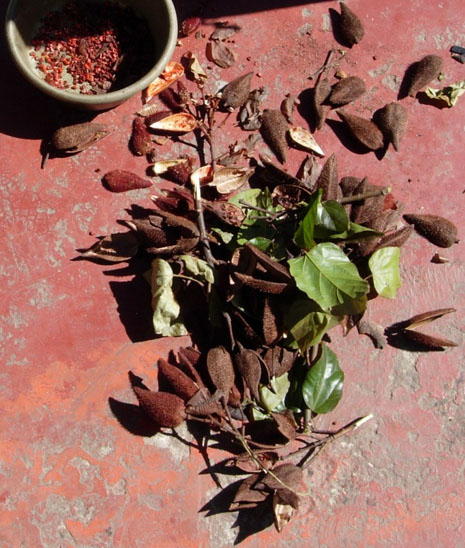
Photograph Copyright by Judith Musick
Art Workshops in Guatemala provided our group of seven women travelers with a wonderful teacher: fiber artist Karen Searle. Karen led us to many talented artisans she has come to know over the years. Some of these women make and use natural dyes. After climbing up a steep hillside in San Juan la Laguna, a village on Lake Atitlan, we found ourselves at a cooperative specializing in natural dyes. Here we met with Philomena, one of the co-op members, in her home, which also serves as the co-op's workshop. Demonstrating the use of achiote, she took the seeds from the seedpods of the achiote plant and ground them on a flat stone, called a metate, using a log-shaped stone, called a mano as the grinder. The fresh seed-pods yield a paler color than the dried ones, with the husks also used for dyeing. The liquid inside banana tree stalks acts as a mordant in this process when it is submerged in boiling water.
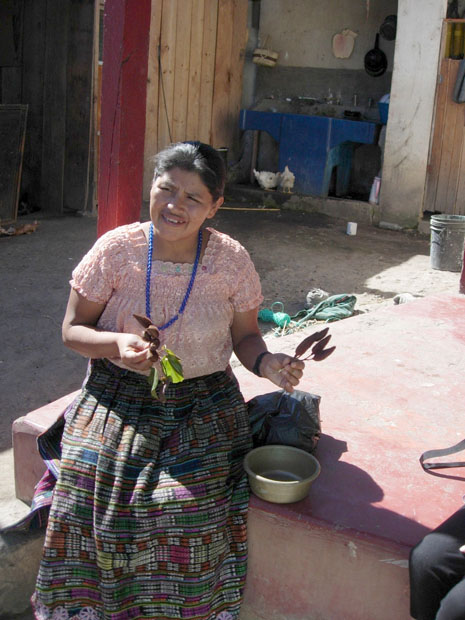
Photograph Copyright by Judith Musick
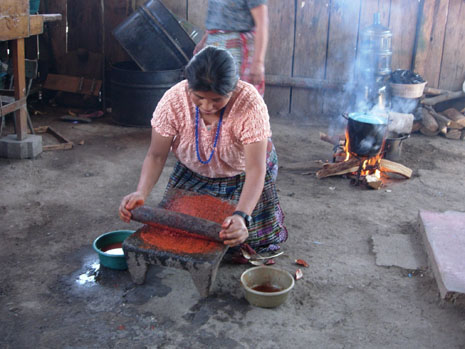
Photograph Copyright by Judith Musick
After the dye process was completed, I dipped a stick in the dye pot and asked one of my traveling companions to "paint" my white cotton tank top. The color dried to a rusty red and has since withstood two washings without fading in the slightest. Another woman put her rayon shirt in the dye pot and it came out as a paler, peach color. In Guatemala, achiote is used for more than fabric dye, it is also to season as well as color food: indeed, the chicken I had eaten at a restaurant the previous night had been spicily seasoned with achiote, also known as annatto.
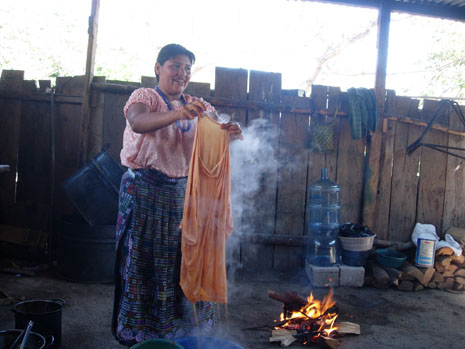
Photograph Copyright by Judith Musick
There was a small shop in Philomena's house selling scarves, table-runners and other naturally-dyed items created by co-op members and then, another shop up the (increasingly steep) hill with items from another group. In both shops the cloth was in shades of soft beige, pale blues and yellows, pale grayish-blues, pale purplish-blues and soft browns. In addition to achiote, the local artisans use pericon, sacatintas, indigo, and a dye improbably called "Nancy" made from tree bark.

Photograph Copyright by Judith Musick
Later in the day, we visited a remarkable enterprise situated on the grounds of a 'camp' for families left homeless by mudslides or damage from Hurricane Stan. This relatively new project was started by a woman from the U.S. who is one of the owners of Posada Santiago, the hotel where we stayed on Lake Atitlan. Here women re-learn some of their own 'lost' blackstrap weaving and embroidery traditions, and use natural dyes in addition to chemical dyes. Currently, they sell their products only in Guatemala, but hope to broaden their market to other countries. The profits go towards the education of local children. When we arrived, several women were tie-dyeing cotton yarns with a natural dye called campeche, and I couldn't resist adding more designs to my tee shirt, this time in the grayish/blue-purple color imparted by the campeche.
The use of natural dyes is being revived here and there in Guatemala, but is far from common practice because of its higher costs in time and money. Nonetheless, I did see yarn and cloth colored by a variety of natural dyes such as: 1) the bark of a tree called hilamo, a reddish-brown color; 2) coconut shell, a pinkish-beige; 3) cochineal, a 'dirty' wine color when used with pomegranate skin as a mordant; 4) St. John's Wort, a yellowish color; and, 5) allizarian, a mustard-yellow dye from the bark of a tree. Several women told of using pomegranate juice, charcoal, avocado, and other fruit seeds, fruits and lichens as dyes. Most interestingly, they rub a mollusk through a fiber to irritate (but not kill) it, causing it to exude a dye that imparts a purple of grayish or crimson tone.
At home now, I am trying to capture the colors of Guatemala in a tapestry I am weaving. Using mostly naturally dyed wool yarns, I attempt to merge the colors and images of this journey with those of earlier trips to Japan and West Africa. In doing this, I reflect on the Guatemalan artisans' ability to create and take colors from nature when possible, merging them with other colors when necessary and creating practical beauty wherever and however they can. As a developmental psychologist whose work has been primarily with girls and women living in difficult circumstances in this country and abroad, I was especially moved to see women honoring and reviving traditional dyeing skills, when it would be easier and less costly to do otherwise.
 Turkey Red Journal
Turkey Red Journal
